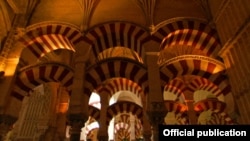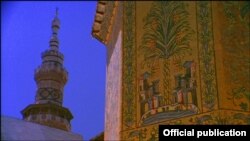The finery of tapestry and carpets, the grandeur of soaring arches in mosques and palaces, and the beauty of calligraphy are just some of the art forms highlighted in a new film by Unity Productions Foundation, Islamic Art: Mirror of the Invisible World. The 90-minute documentary explores Islam’s contribution to world art and culture through 1,400 years and across four continents.
Narrated by actress Susan Sarandon and shot on location from Iran to West Africa, the film features several examples of Islamic art illustrating how Muslim craftsmen used art to express their faith.
One of the documentary's executive producers - Michael Wolfe, author of Taking Back Islam: American Muslims Reclaim Their Faith - says it helps highlight Islam’s contribution to world culture.
“There is a driving motivation behind the film to come to an understanding that this is - that Muslim culture emanates from a large history and a large number of people alive on the Earth today who take a real interest in this work, in this kind of artistic expression,” said Wolfe.
“In screening this film in so many different museums around the country, I have come to realize that people are really avid to learn a little more about the conversation that has been taking place over centuries between Western art and Islamic art,” he added.
Watch related video:
Elements
The film is not an exhaustive treatment of Islamic art - though it’s high-definition video and interviews with scholars are more than a taste of the subject. Through compelling visuals and narration, the film breaks Islamic art up into several categories: The Word, Space, Ornament, Color and Water. Each category is used to illustrate how Muslim artists of the past 1,400 years have used various art forms to express their faith.
The film explores the motive behind the beauty of Arabic calligraphy - including quotes from the Quran - something Michael Wolfe says was a driving force in much of the art featured.
“You know, the language - the written language of Arabic arrived on the scene about the same time as the Quran,” said Wolfe. “The codification of the Quran became the inspiration for developing a written language. So it comes from a very spiritual place. And very early on in the development of the written language people tried to make it beautiful.”
Islamic Art also features several striking examples of Islamic architecture. The Alhambra Palace, the great mosques of Damascus and Cordoba, the Shaykh Lutfallah mosque and the Taj Mahal highlight the film with their use of geometric, zoomorphic, and floral designs, their striking colors, and their intricate patterns.
Expressions of faith in art
Producer Michael Wolfe says he hoped to show how Muslim artists thought design and beauty were important in all objects - from grand buildings to everyday items like bowls or plates.
“So you might say that the language of art in Islamic culture is purveyed through just about every daily and minor and tiny and vast expression you can think of,” he said. “It makes for a wonderful kind of variety and diversity in the work.”
The film also touches on the use of geometric patterns in Islamic art, and the importance of geometry to the faithful - from orienting a mosque towards Mecca, to navigation in the desert and on the sea, to its use in designing and creating elaborate interior courtyards, domes, and ceilings meant to evoke a vision of paradise.
That vision of paradise carries through the film’s discussion of color, ornament and water as well. Viewers are shown artisans weaving elaborate textiles and making delicate pietra dura ornaments. Also, they are taken to lush gardens stimulating the senses with fruit trees, shrubbery, fountains, water channels and flowers.
Even the mud bricks and scaffolding of the great mosque at Djenné in Mali - with long shadows cast across its exterior - evoke a sense of a place set aside for a unique experience with the numinous.
Hope for understanding
Producer Michael Wolfe said that there are many examples of Islamic art they could not show - both because of time and because of expense. But he said he hopes viewers will take away an appreciation of Islam’s contribution to art and culture.
“So in the end you get a feeling from this film, I think, of what human beings value over the centuries,” he said.
“What do we really take away? Is it the strife and the tension that we experience sometimes on a daily level? I don’t think so. Is it even the wars and the disagreements? Again, I don’t think so. What we put in our museums is not the representations of war and strife; they are the representations of art and beauty. And these are the things that we end up regarding as the real products of our societies on the planet,” Wolfe added.
The film is put out by Unity Productions Foundation, a Virginia-based, non-profit which says on its website that it “produces documentary films for both television broadcast, online viewing, and theatrical release, and implements long-term educational campaigns aimed at increasing understanding between people of different faiths and cultures, especially between Muslims and other faiths.”
Wolfe is one of the organization’s co-founders along with co-executive producer Alex Kronemer. Other films put out by Unity Productions Foundation include Muhammad: Legacy of a Prophet; Inside Islam: What a Billion Muslims Really Think; Cities of Light: the Rise and Fall of Islamic Spain; On a Wing and a Prayer: An American Muslim Learns to Fly; and Allah Made Me Funny, a profile of an Islamic comic.
Islamic Art: Mirror of the Invisible World is part of the United States Public Broadcasting Service’s summer series and will be broadcast nationwide in the U.S. on July 6.
Narrated by actress Susan Sarandon and shot on location from Iran to West Africa, the film features several examples of Islamic art illustrating how Muslim craftsmen used art to express their faith.
One of the documentary's executive producers - Michael Wolfe, author of Taking Back Islam: American Muslims Reclaim Their Faith - says it helps highlight Islam’s contribution to world culture.
“There is a driving motivation behind the film to come to an understanding that this is - that Muslim culture emanates from a large history and a large number of people alive on the Earth today who take a real interest in this work, in this kind of artistic expression,” said Wolfe.
“In screening this film in so many different museums around the country, I have come to realize that people are really avid to learn a little more about the conversation that has been taking place over centuries between Western art and Islamic art,” he added.
Watch related video:
Elements
The film is not an exhaustive treatment of Islamic art - though it’s high-definition video and interviews with scholars are more than a taste of the subject. Through compelling visuals and narration, the film breaks Islamic art up into several categories: The Word, Space, Ornament, Color and Water. Each category is used to illustrate how Muslim artists of the past 1,400 years have used various art forms to express their faith.
The film explores the motive behind the beauty of Arabic calligraphy - including quotes from the Quran - something Michael Wolfe says was a driving force in much of the art featured.
“You know, the language - the written language of Arabic arrived on the scene about the same time as the Quran,” said Wolfe. “The codification of the Quran became the inspiration for developing a written language. So it comes from a very spiritual place. And very early on in the development of the written language people tried to make it beautiful.”
Islamic Art also features several striking examples of Islamic architecture. The Alhambra Palace, the great mosques of Damascus and Cordoba, the Shaykh Lutfallah mosque and the Taj Mahal highlight the film with their use of geometric, zoomorphic, and floral designs, their striking colors, and their intricate patterns.
Expressions of faith in art
Producer Michael Wolfe says he hoped to show how Muslim artists thought design and beauty were important in all objects - from grand buildings to everyday items like bowls or plates.
“So you might say that the language of art in Islamic culture is purveyed through just about every daily and minor and tiny and vast expression you can think of,” he said. “It makes for a wonderful kind of variety and diversity in the work.”
The film also touches on the use of geometric patterns in Islamic art, and the importance of geometry to the faithful - from orienting a mosque towards Mecca, to navigation in the desert and on the sea, to its use in designing and creating elaborate interior courtyards, domes, and ceilings meant to evoke a vision of paradise.
That vision of paradise carries through the film’s discussion of color, ornament and water as well. Viewers are shown artisans weaving elaborate textiles and making delicate pietra dura ornaments. Also, they are taken to lush gardens stimulating the senses with fruit trees, shrubbery, fountains, water channels and flowers.
Even the mud bricks and scaffolding of the great mosque at Djenné in Mali - with long shadows cast across its exterior - evoke a sense of a place set aside for a unique experience with the numinous.
Hope for understanding
Producer Michael Wolfe said that there are many examples of Islamic art they could not show - both because of time and because of expense. But he said he hopes viewers will take away an appreciation of Islam’s contribution to art and culture.
“So in the end you get a feeling from this film, I think, of what human beings value over the centuries,” he said.
“What do we really take away? Is it the strife and the tension that we experience sometimes on a daily level? I don’t think so. Is it even the wars and the disagreements? Again, I don’t think so. What we put in our museums is not the representations of war and strife; they are the representations of art and beauty. And these are the things that we end up regarding as the real products of our societies on the planet,” Wolfe added.
The film is put out by Unity Productions Foundation, a Virginia-based, non-profit which says on its website that it “produces documentary films for both television broadcast, online viewing, and theatrical release, and implements long-term educational campaigns aimed at increasing understanding between people of different faiths and cultures, especially between Muslims and other faiths.”
Wolfe is one of the organization’s co-founders along with co-executive producer Alex Kronemer. Other films put out by Unity Productions Foundation include Muhammad: Legacy of a Prophet; Inside Islam: What a Billion Muslims Really Think; Cities of Light: the Rise and Fall of Islamic Spain; On a Wing and a Prayer: An American Muslim Learns to Fly; and Allah Made Me Funny, a profile of an Islamic comic.
Islamic Art: Mirror of the Invisible World is part of the United States Public Broadcasting Service’s summer series and will be broadcast nationwide in the U.S. on July 6.







